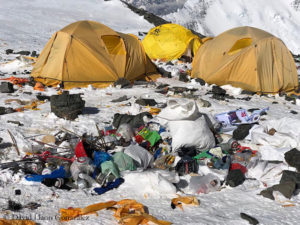I don’t give a damn. According to this maxim many mountaineers seem to be en route on the highest mountains in the world. Instead of removing their fixed ropes, they leave them hanging, instead of taking their garbage with them, they leave it lying there. Vassily Pivtsov, leader of the K2 winter expedition from Kazakhstan, Russia and Kyrgyzstan, reported that he and his team mates had found a lot of used and full oxygen bottles below House’s Chimney, one of the key points of the route via the Southeast Ridge, as well as further rubbish like old tents.
Entangled fixed ropes, littered high camps
The situation on other eight-thousanders or highly frequented seven-thousanders is similar. At the time of the pioneers in the 1950s, 60s and 70s, when only from time to time a group of climbers tackled a mountain in the Himalayas and Karakoram, this may have been considered folklore. Then a mountaineer might even have been happy to find a can of tuna or a bar of chocolate in an old tent left behind in the high camp. Today, however, in the age of commercial climbing on the eight-thousanders, the leftover of earlier expeditions are a nuisance. At the key points there are whole clusters of fixed ropes, the high camp spots are littered with garbage.
Rules on waste disposal
There are regulations on waste disposal for the base camps, which are – more or less strictly – controlled. In the high camps, however, the problem has not yet been solved satisfactorily. After all, there are initial approaches: Starting this spring, for example, the Chinese-Tibetan authorities will demand a “rubbish collection fee” of 1,500 US dollars per Everest climber, on Cho Oyu and Shishapangma 1,000 dollars each. In addition, all members will be required after the expedition to hand in eight kilograms of garbage per person from the mountain to the responsible Chinese liaison officers in the base camp. On the Nepalese south side of Everest, Sherpas receive premiums per kilogram of garbage they bring down from the mountain. However, this means that ripped tents and tarps, for example, tend to stay up there because they weigh comparatively little.
No trivial offence
There have been so-called clean-up expeditions in recent years not only on Everest, but also on K2, where climbers led by Italian Maurizio Gallo brought tons of rubbish from the slopes of the mountain to the valley. These missions are honourable, but remain a drop in the ocean if the attitude of the great majority of mountaineers does not change. They must finally understand that it is not a trivial offence to leave fixed ropes and garbage behind. Perhaps the extremely littered mountains should be simply closed and only be opened again when all the fixed ropes and other rubbish have been removed from their slopes. It would be exciting to see how many mountaineers would take part in such actions.
Actually
Actually, mountaineers and climbers boast about loving nature. Actually, they should know that they are harming nature by leaving their rubbish behind. Actually, they should know that they also bear a responsibility for their children and grandchildren, who should grow up in an environment worth living in. Actually, one should not have to emphasize that eight-thousanders and all other mountains (the problem does not only exist in the Himalayas and Karakoram!) are not dumps. Actually, one should assume that humans are rational beings. Actually.
P.S. You are not missing anything on the winter expeditions on K2 and Nanga Parbat. It’s snowing on both eight-thousanders. The weather is not supposed to improve until Saturday and then only temporarily. So the climbers are once again forced to exercise themselves in patience in the base camps.



